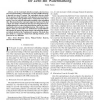Free Online Productivity Tools
i2Speak
i2Symbol
i2OCR
iTex2Img
iWeb2Print
iWeb2Shot
i2Type
iPdf2Split
iPdf2Merge
i2Bopomofo
i2Arabic
i2Style
i2Image
i2PDF
iLatex2Rtf
Sci2ools
CORR
2006
Springer
2006
Springer
A constructive and unifying framework for zero-bit watermarking
In the watermark detection scenario, also known as zero-bit watermarking, a watermark, carrying no hidden message, is inserted in a piece of content. The watermark detector checks for the presence of this particular weak signal in received contents. The article looks at this problem from a classical detection theory point of view, but with side information enabled at the embedding side. This means that the watermark signal is a function of the host content. Our study is twofold. The first step is to design the best embedding function for a given detection function, and the best detection function for a given embedding function. This yields two conditions, which are mixed into one 'fundamental' partial differential equation. It appears that many famous watermarking schemes are indeed solution to this 'fundamental' equation. This study thus gives birth to a constructive framework unifying solutions, so far perceived as very different.
| Added | 11 Dec 2010 |
| Updated | 11 Dec 2010 |
| Type | Journal |
| Year | 2006 |
| Where | CORR |
| Authors | Teddy Furon |
Comments (0)

